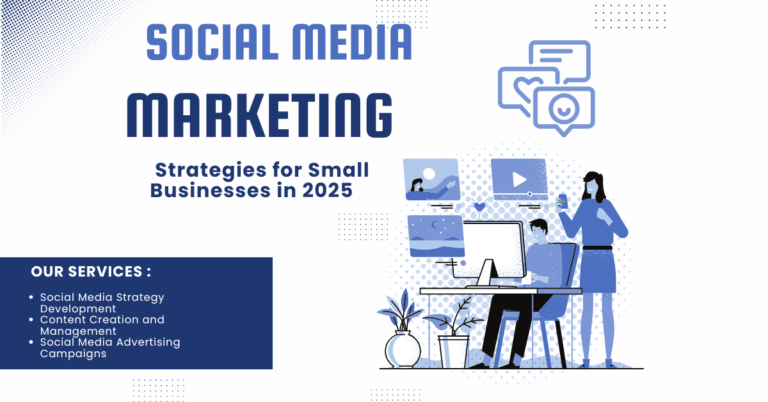In 2025, social media continues to evolve rapidly, transforming the way small businesses connect with their target audience.
As digital platforms grow more sophisticated, small businesses must adapt their strategies to remain competitive and visible. Social media marketing is no longer just about posting regularly; it’s about strategic planning, authentic engagement, and leveraging the latest technologies to build lasting relationships with customers.
This article explores the most effective social media marketing strategies for small businesses in 2025, helping you stay ahead of the curve and achieve measurable results.
1. Embrace Video-First Content
Video content is the dominant format on all major platforms, from Instagram Reels and YouTube Shorts to TikTok and Facebook Stories. In 2025, users consume short, engaging, and informative videos at an unprecedented rate. For small businesses, this means creating compelling video content that educates, entertains, or solves a problem.
You don’t need a big budget to produce quality video. Smartphones now have high-resolution cameras, and free editing apps can help create polished videos. Focus on storytelling, behind-the-scenes content, customer testimonials, and product demos to engage your audience.
2. Leverage AI-Driven Tools for Content Creation
Artificial Intelligence is no longer just for big corporations. Today, AI-powered tools are accessible to small businesses and can help with content creation, scheduling, and audience analysis. These tools analyze user behavior and preferences, enabling you to create personalized content that resonates with your target market.
Use AI to generate content ideas, write captions, suggest posting times, and even create visuals. This saves time and ensures your content aligns with current trends and audience interests.
3. Prioritize Authenticity and Human Connection
Consumers in 2025 are more interested in brands that are authentic and transparent. Small businesses have a unique advantage in this area because they can create closer, more personal connections with their audience.
Show the human side of your business. Share your story, introduce your team, and talk about your values. Respond to comments, ask for feedback, and engage in genuine conversations with followers. Authenticity builds trust and encourages customer loyalty.
4. Use Micro-Influencer Marketing
Influencer marketing remains a powerful tool, but the focus has shifted to micro-influencers—individuals with smaller but highly engaged audiences. Micro-influencers are more affordable and often generate better engagement rates compared to celebrities or large influencers.
Partner with micro-influencers in your niche who share your brand values. Their recommendations feel more authentic and can significantly boost your reach and credibility.
5. Implement Social Commerce Features
Social commerce is growing rapidly, enabling users to shop directly through social media platforms. In 2025, platforms like Instagram, Facebook, and TikTok offer seamless shopping experiences without users needing to leave the app.
Small businesses should take advantage of these features by setting up shoppable posts, integrating product catalogs, and using live shopping events. This not only simplifies the customer journey but also increases conversion rates.
6. Focus on Niche Communities
Rather than targeting broad audiences, small businesses should focus on building and engaging with niche communities. These are groups of users who share common interests, values, or lifestyles.
Join and participate in relevant Facebook Groups, Reddit threads, or LinkedIn communities. Better yet, create your own community around your brand. This helps build a loyal following and creates a space for direct engagement and feedback.
7. Optimize for Each Platform
Each social media platform has its own algorithms, features, and audience behavior. What works on Instagram may not work on LinkedIn or TikTok. In 2025, platform-specific content strategies are crucial.
Tailor your content for each platform’s strengths. For example, use professional, thought-leadership posts on LinkedIn, visual storytelling on Instagram, and entertaining, short-form videos on TikTok. Understanding and optimizing for each platform increases visibility and engagement.
8. Prioritize Mobile Optimization
With the majority of social media users accessing platforms via smartphones, mobile optimization is more important than ever. Ensure that all your content, including links and landing pages, is mobile-friendly.
Use vertical videos, concise captions, and fast-loading visuals. A smooth mobile experience keeps users engaged and reduces bounce rates, contributing to better performance and more conversions.
9. Measure Performance and Adapt
Data-driven decision-making is a key strategy in 2025. Social media platforms provide detailed analytics that help track engagement, reach, conversion rates, and more.
Use these insights to understand what’s working and what’s not. A/B test different formats, posting times, and messaging. Regularly review your social media performance and be ready to adjust your strategy to improve results.
10. Encourage User-Generated Content
User-generated content (UGC) is powerful because it comes from real customers. It includes photos, videos, reviews, and testimonials shared by users. UGC acts as social proof and influences potential buyers.
Encourage your customers to share their experiences using your products or services. Run contests, giveaways, or campaigns that incentivize UGC. Share this content on your channels to build credibility and trust.
11. Stay Updated with Trends and Algorithms
Social media is constantly changing, with new trends and algorithm updates emerging regularly. Small businesses need to stay informed and be agile in their approach.
Follow industry blogs, attend webinars, and join marketing communities to stay up to date. Testing new features early—like interactive polls, augmented reality filters, or new ad formats—can give you a competitive advantage.
12. Integrate Social Media with Overall Marketing Strategy
Social media should not operate in isolation. It must align with your overall marketing goals, brand message, and customer journey. Coordinate social media campaigns with email marketing, content marketing, and paid advertising efforts.
Consistent messaging across all channels reinforces brand identity and increases the effectiveness of your marketing strategy.
Conclusion
In 2025, social media marketing offers small businesses unprecedented opportunities to grow, connect, and thrive. The key lies in embracing new technologies, prioritizing genuine connections, and being adaptable to change. By implementing these strategies, small businesses can build strong online communities, drive meaningful engagement, and ultimately increase revenue.
Focus on delivering value, being authentic, and continuously learning. With the right approach, social media can become your most powerful tool for business growth in the digital age





